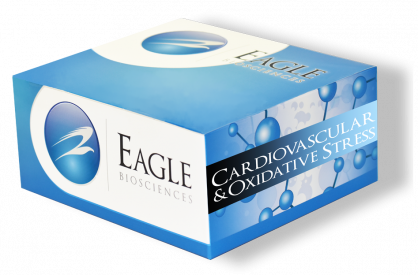Apolipoprotein A1 ELISA Assay Kit
For Research Use Only
Size: 1×96 wells
Sensitivity: 4.9 ng/ml
Dynamic Range: 5-5000 ng/ml
Incubation Time: 3.5 hours
Sample Type: Serum, Plasma
Sample Size: 100 µL
$1,285.00
The Eagle Biosciences Apolipoprotein A1 ELISA Assay Kit is intended for the quantification of Apolipoprotein A1 in human plasma and serum samples. The Eagle Biosciences Apolipoprotein A1 ELISA Assay Kit is for research use only and should not be used for diagnostic procedures.
For Research Use Only
Size: 1×96 wells
Sensitivity: 4.9 ng/ml
Dynamic Range: 5-5000 ng/ml
Incubation Time: 3.5 hours
Sample Type: Serum, Plasma
Sample Size: 100 µL
Apolipoprotein A-I is the major protein component of high density lipoprotein (HDL) in plasma. The protein promotes cholesterol efflux from tissues to the liver for excretion, and it is a cofactor for lecithin cholesterolacyltransferase (LCAT) which is responsible for the formation of most plasma cholesteryl esters. This gene is closely linked with two other apolipoprotein genes on chromosome 11. Defects in this gene are associated with HDL deficiencies, including Tangier disease, and with systemic non-neuropathic amyloidosis. Apolipoprotein A1 participates in the reverse transport of cholesterol from tissues to the liver for excretion by promoting cholesterol efflux from tissues and by acting as a cofactor for the lecithin cholesterol acyltransferase (LCAT). As part of the SPAP complex, activates spermatozoa motility.
The Eagle Biosciences Apolipoprotein A1 ELISA Assay Kit employs the sandwich enzyme immunoassay technique for the detection of Human Apolipoprotein A1 in human plasma and serum samples. Human Apolipoprotein A1 will bind to the capture antibody coated on the microtiter plate. After appropriate washing steps, anti-Human Apolipoprotein A1 primary antibody binds to the captured protein. Following a washing to remove unbound substances, secondary antibody conjugated to Horseradish Peroxidase (HRP) is added to each microplate well and incubated. After washing away any unbound antibody-enzyme reagent, a substrate solution (TMB) is added to the wells and color develops in proportion to the amount of Apolipoprotein A1 bound in the initial step. The color development is stopped by the addition of acid and the intensity of the color is measured at a wavelength of 450nm ±2nm. The concentration of Apolipoprotein A1 in the sample is then determined by comparing the O.D of samples to the standard curve.
